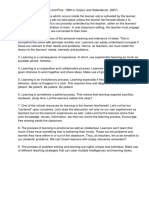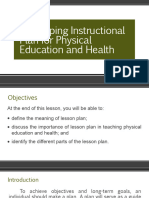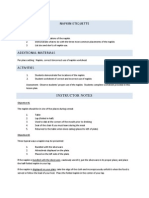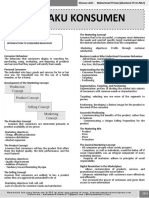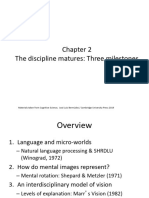Module 6
Module 6
Uploaded by
Elizabeth GaurinoCopyright:
Available Formats
Module 6
Module 6
Uploaded by
Elizabeth GaurinoOriginal Description:
Copyright
Available Formats
Share this document
Did you find this document useful?
Is this content inappropriate?
Copyright:
Available Formats
Module 6
Module 6
Uploaded by
Elizabeth GaurinoCopyright:
Available Formats
Module 6: The Teacher, a key figure in curriculum development
Module 6 THE TEACHER, A KEY FIGURE IN CURRICULUM DEVELOPMENT
Objectives
After reading this module, you will be able to do these: 1. Identify the general functions, instruction competencies, personal characteristics of a good teacher accurately. 2. Make your own teachers creed accurately. 3. Value the crux of a teacher of the molder of all professions. 4. Value the importance of helping teacher to grow professionally. 5. Apply all the functions, instructional competencies, and characteristics of a good teacher effectively.
Concepts
Quality education requires quality teachers. Good teachers bring a shining light into the learning environment. They are ideal companions of the learning environment. They are ideal companions of the learners. Passion for teaching and a passion for students is the best word to characterize a teacher.
Introduction to Curriculum Development
Module 6: The Teacher, a key figure in curriculum development
Essential Questions
Observe your teacher carefully give your observation by answering the following questions. 1. How do teachers show passion in teaching? 2. How does mastery of the subject matter is shown by the teacher? 3. What are the good traits that the teacher should posses? 4. What is the importance of the teacher in the teaching-learning process? 5. Do teachers personalities affect the student? How?
Introduction
The teacher is a notable figure in curriculum development. This is because the teacher occupies the center stage in divulging learning. Through his hands pass all the future citizens of the country. He is the molder of the future leaders of the nation. This module discusses
Lesson Proper
General Functions of a Teacher What are the functions of the teacher that make in an important person? The following are the general function of a teacher: 1. Instructional function. It is the most important thing that the teacher should have especially when they are teaching younger students. It is done by imparting to the students or helping the students to acquire the necessary cognitive knowledge, affective knowledge or right attitudes, and psychomotor skills that the
Introduction to Curriculum Development 2
Module 6: The Teacher, a key figure in curriculum development
students need to make them good, useful and productive citizens and not liabilities to society. 2. Evaluative function. It is a component of effective instruction. It is necessary to determine whether objectives of instruction have been carried out and learning or understanding of lesson has taken place. It is only by knowing the effectiveness of instruction that teachers can determine the value of worth of the lesson as well as the specific procedure that go with the teaching-learning process. 3. Preservation of knowledge function. Usually, a teacher to maintain a library with collections of books, encyclopedias, almanacs, journals and other printed materials which contain different kinds of knowledge and information.in this way, the teacher is preserving knowledge. These library materials will be inherited by heirs for their use and by other people. 4. Extension of knowledge function. When a teacher conducts researches and discovers, new facts, principles and other information, he is extending knowledge. He also performs this function when he writes books and articles about education and other things. 5. Guidance and discipline function. Every teacher is a guidance teacher. He has to guide and help his students especially when they have problems. He has to help them make wise decisions especially in the choice of their life careers. He has to help them develop a well discipline and independent life. This is especially necessary when the teacher assumes the position of a loco parentis to his students. He must exert his influence to induce his students to develop themselves into good, useful and productive citizens, independent minded, with analytical critical and creative thinking. He has to develop his students into ambitious achievers of things that bring benefit not only to themselves but to society as well. 6. Auxiliary function. The school has to perform multifarious activities in order to be able to accomplish its missions which are to develop good plans out of its
Introduction to Curriculum Development
Module 6: The Teacher, a key figure in curriculum development
students and the attainment of national development goals. The teacher has to contribute his technical know-how to the performance of the needed activities. He maybe a member or head of a committee which accomplishes certain type of work to help make the school successful in the attainment of its mission. Instructional competencies of a good teacher First of all, the teacher must be fully qualified educationally. No one can teach without the proper educational qualification. Aside from being qualified educationally, the teacher must have the following instructional competencies to make him a good teacher: 1. Mastery of the subject matter. The teacher has to master his subject matter. The logic behind this is that no one can give what he does not have. A teacher cannot teach a subject if he knows nothing about it. A well trained and certificated teacher must show evidence of mastery of subject matter. According to Dunhill (2000) teacher knowledge must be of two fold nature. A good teacher must first possess a wide general knowledge and within the confines of this general knowledge, a sound understanding of the subject he is to teach in the classroom. Quadri K. et al (2004) corroborate that a good teacher must be well knowledge versed in his area of specialization. 2. Mastery of the medium of instruction. A medium of instruction is the language used by a teacher to teach students. Simply put, it is a means of conveying information to students. Such a medium could be the official language in the country or it could be the native mother tongue of the students. Deciding which language to use for instruction is important because it can affect the way the students learn. Someone who grew up speaking French or Russian might not adapt easily to the concept of learning in English. In situations like that, a combination of the mother tongue and the chosen medium of instruction will work better, until the person is more confident in the new language. For instance, if it is a bilingual type of education and the students are a
Introduction to Curriculum Development
Module 6: The Teacher, a key figure in curriculum development
mixture of Spanish and English, the medium of instruction will not be only English, but rather a mixture of Spanish and English. In multilingual education, the language of instruction will not be just one language; it will also include two or more other languages. 3. Mastery of effective methods, strategies, techniques and approaches of
teaching. A carpenter with crude tools and methods cannot produce fine
furniture. The same is true with a teacher. The methods, strategies, techniques and approaches of teaching are the tools of the teacher. If he does not have the mastery of using effectively any of these tools, he cannot produce a fine graduate. The teacher must have mastery of using at least one method of teaching his subject matter so that he can teach his subject matter in the most effective way to produce the desired outcomes. 4. Mastery of lesson planning and organizing instructional materials. Planning the lesson and classroom activities to the teacher. Good lesson plans ensure the smooth flow of the teaching-learning activities to that maximum learning will take place. Good lesson plans enables the teacher to accomplish his lesson within the planning is usually required and used but in the tertiary levels, at term lesson plan called syllabus is used. In planning his lesson, the teacher must also know and locate the rich community resources for instructional purposes. This is so because the lesson is as the availability of adequate materials but they are mostly verbal while the environment bound in concrete and audio-visual aids. 5. Mastery of psychology of learning or educational psychology. The teacher should have a mastery of the principles of learning that make students learn better and faster so that he can apply them in his teaching. He must know the factors that facilitate learning such as learning by doing, motivation, reinforcement, discipline, how to deal with individual differences, development of
Introduction to Curriculum Development
Module 6: The Teacher, a key figure in curriculum development
critical and creative thinking, wise decision-making, self-reliance and countless others to that he can me his teaching very effective and enjoyable too. 6. Mastery of formulating instructional goals and objectives. Instructional goals and objective are those that deal with the subject matter being taught only. It is important that the teacher must know the objectives of the institution he is serving and those of the nation. This is so because the teachers goals and objectives must be in accordance with the goals and objectives of the school and of the nation. 7. Mastery of classroom management including discipline. A classroom reveals telltale signs of its users style. Typically, a well-organized classroom has various instructional organizers, such as rules, posted on walls. Books and supplies are organized so that often needed ones are easily accessible. The furniture arrangement and classroom displays often reveal how the teacher uses the space. Once the students enter, the details of a classroom at work are evident. The teachers plan for the environment, both the organization of the classroom and of students, allows the classroom to run itself amid the buzz of student and teacher interaction. 8. Mastery of measurement and evaluation. It is important that the teacher must know the effectiveness of his teaching methods and so he must measure the results of his teaching, the achievement of his construction of measuring instrument to measure the achievements of his students. The measuring instrument or test may be oral, written or tests of performance. If the tests are written, they may be essay or objective the result of the test are used to guide the teacher in instituting remedial measures if needed and, therefore, the tests papers must be checked at once and returned to the students for the corrections of their errors. Most important is the mastery of the teacher in transmitting the raw scores into grades with utmost fairness and no bias or partiality at all for all the purpose of promotion or retention.
Introduction to Curriculum Development
Module 6: The Teacher, a key figure in curriculum development
9. Mastery of the techniques of motivation. Motivation is arousing the interest of the student in the lessons. Motivation is important because this is a way of making the students ready to learn. If they are ready to learn they become interested in the lesson and they learn. Hence, the teacher should master all the techniques of motivation to arouse and maintain the interest of the students in their lessons to make them learn. 10. Mastery in the art of questioning. The most valuable method of conducting a recitation is the question method. The teacher who knows how to question his class has fairly mastered the pedagogic art. The prime object of teaching is to get pupils to think rightly. Judicious questioning is the best means of arousing mental activity. To secure intellectual growth the attention of the child must be arrested, his interest in the subject created or intensified, definiteness of thought promoted, studious habits cultivated, and energy and enthusiasm aroused. In no way has the teacher greater power to secure good results than by the use of the question method of teaching. It affords pupils a valuable training in readiness of thought and speech. It promotes mental development, and secures good discipline. It is the object of questioning to give proper direction to the thoughts of the learner, to ascertain what he knows of the subject, to detect and correct any errors into which he may have fallen, to bring out the important details of the subject, to unfold the principles involved, to foster self-effort in the discovery of truth, and to train to habits of reflection. Personal characteristics of a good teacher Teachers vary a great deal with regard to the quality such elements as personal appearance, emotional stability, maturity of thought and action, sense of humor, sociability, poise, animation, congenial manner, and temperament. The total pattern of these qualities has a tremendous impact upon the pupil. As a matter of fact, a teacher with a unique set of personal qualities such as geniality, sense of humor, enthusiasm, and
Introduction to Curriculum Development
Module 6: The Teacher, a key figure in curriculum development
sparkling facial expressions can contribute significantly to the mental, social, and emotional development of students. Aside from his teaching competencies, a teacher must also possess good personal characteristics which will make him a better teacher. Here are some desirable characteristic that make a better teacher: 1. Affection. It is the basic traits that a teacher needs to have. Every one of us expects a certain amount of affection in every teacher. There is no human being on the earth who does not crave affection from those around, especially from parents and teachers. A teacher should show love and concern for his pupils. Without affection a teacher cannot feel for his pupil wanted and accepted. 2. Empathy. Empathy enables us to feel concerned with our pupils' problems and the efforts we make to cope with them. This quality enables us to understand our pupils better both emotionally as well as intellectually. On the child's eye view we need a lot of emotional, flexibility. Empathy enables us to be judicious, impartial and objective. Empathy creates in us a better awareness of the functioning of a child's mind which in term would permit us to avoid the use of words that insult and actions that hurt. As a teacher we must has empathy as a personal quality. 3. Concern and Commitment. In a teacher there must be two more qualities viz. genuine concern and commitment to the tasks. As dedicated and concerned about the development of our pupils as their parents generally arc and then try to do all within our ability to see that they are given an opportunity for their growth and development. If we want to improve our relations with children, we need to unlearn our habitual language of rejection and a new language of acceptance. If we are genuinely interested in the well-being of our pupils, we need to be authentic,
Introduction to Curriculum Development
Module 6: The Teacher, a key figure in curriculum development
genuine and sincere. We do not have to demonstrate hypocrisy by acting nice, when we feel nasty. 4. Humor. The sense of humor is a good trait in a teacher. Whenever we combine elements in a way that is different, unexpected and incongruous, we wind up with humor. As a teacher, we should develop the ability to play spontaneously with ideas, concepts and relationships. The Teachers Creed It is important that a teacher should develop a creed of teaching of his own that will guide him in the performance of his teaching job. The following is a sample of a creed of teaching which may stand improvement:
Introduction to Curriculum Development
Module 6: The Teacher, a key figure in curriculum development
Helping the teacher to grow professionally (faculty development) Faculty development is a key issue and concern at many private-independent schools today. It help schools engage with teachers in a way that enables them to develop and use their talents along lines of excellence for the benefit of their students, colleagues, the school community at large, and themselves. Doing these may help them with self-renewal and growth, and to pursue professional development as they enhance their careers. With the support of their academic administrators, the workbook can help them improve not only their own performance, but improve student performance, satisfaction, and enthusiasm in their classrooms. This is to maintain their teaching proficiency. There are many ways by which the teacher can be helped to grow professionally some of which are the following: 1. Sending the teacher to attend educational seminars, workshops and conferences. 2. Making each teacher a curriculum committee member. 3. Group discussions. 4. Pre-school conferences. 5. Joining professional educational associates. 6. Teachers meetings. 7. Demonstration teaching. 8. Wide readership. 9. Writing educational books and articles. 10. Interschool visitation. 11. Interclass room observation. 12. Supervisory conference. 13. Furthering studies. 14. Research.
Introduction to Curriculum Development
10
Module 6: The Teacher, a key figure in curriculum development
Heres a list of some reasons why professional development plays a critical role in the ongoing growth of teachers. Professional development does support all aspects of academic careers, but understanding its importance to teaching is my emphasis here. Professional development promotes faculty responsibility for continuous, careerlong growth based upon not only the trial and error of experience, but also theory, research, and professional collaboration with colleagues.
The understanding of instructional concepts and teaching processes can be expanded and deepened via professional development. Good teaching is not just a you have it or you dont skill, nor is it an automatic companion of terminal, disciplinary degrees. It is an action, process, and way of thinking and as such it constitutes serious, complex intellectual work. It requires regular reflection and exposure to new ideas and information that are inherently a part of good professional development activities. Professional faculty development connects faculty across disciplines and career stages, serving to create a pedagogical community within the college or university. Professional development is not remedial or something only for those having problems, but should be an integral part of every faculty members efforts to become more effective in the classroom. Although professional development has often been viewed as supplementary within the academy, it actually plays a central role in faculty motivation and vitality across their careers. Without professional development opportunities, faculty are often isolated and unaware of beneficial, innovative pedagogical approaches.
Thats all about Module 6. Now lets move on doing the activity
Introduction to Curriculum Development
11
Module 6: The Teacher, a key figure in curriculum development
Activity
I.
Directions: Write True if the underlined word is correct and False if not. 1. The logic behind this is that no one can give what he does not have. 2. Books and supplies are organized so that often needed ones are easily accessible. 3. The most valuable method of conducting a recitation is the answer method. 4. Empathy enables us to feel concerned with our pupils' problems and the efforts we make to cope with them. 5. It is important that a teacher should develop a creed of teaching of his own that will teach him in the performance of his teaching job. 6. Professional development is a key issue and concern at many privateindependent schools today. 7. Faculty development promotes faculty responsibility for continuous, career-long growth based upon not only the trial and error of experience, but also theory, research, and professional collaboration with colleagues. 8. A pupil can be inspired with a teacher to be honest, punctual, and truthful. 9. The total pattern of these qualities has a tremendous impact upon the pupil. 10. The prime object of learning is to get pupils to think rightly.
II.
Directions: Answer the following questions. 1. Why is the teacher the key figure in curriculum development? (3pts.) 2. Choose an instructional competency that a teacher ought to have and discuss. 3. Choose a way by which teachers may be helped to grow professionally and discuss.
Introduction to Curriculum Development
12
Module 6: The Teacher, a key figure in curriculum development
References
Book Source Corpuz, Brenda B. and Salandanan, Gloria G. Principles of Teaching 1.2nd Edition. 2011. Lorimar Publishing, INC. page 12-15 Aquiono, Gaudencio and Razon, Perpetua. Educational Psychology. 1993. Rex bookstore. Page 397-399 Electronic Sources Onike, Rahaman. Teacher As a Key Factor Affecting Learning. Retrieved http://searchwarp.com/swa596810-Teacher-As-A-Key-Factor-AffectingLearning.htm Del Rio, Annsharina and Lopez, Jezreel S. Bilingual Mastery as Effectual Medium of Instruction in General Education Courses. Retrieved http://iamure.com/publication/index.php/ije/article/view/428 Published 1897. Retrieved http://www.oldandsold.com/articles24/schoolmanagement-15.shtml Altany, Alan. Professional Faculty Development: The Necessary Fourth Leg. Retrieved http://www.facultyfocus.com/articles/faculty-development/professionalfaculty-development-the-necessary-fourth-leg/
Introduction to Curriculum Development
13
Module 6: The Teacher, a key figure in curriculum development
Answer key
True or False 1. True 2. True 3. False 4. True 5. False 6. False 7. False 8. True 9. True 10. False
Introduction to Curriculum Development
14
You might also like
- Prof Ed 12 JessaDocument3 pagesProf Ed 12 JessaClarizza Mae Abejo100% (1)
- Cayanan Ronilyn Clariz L - FS Learning Episode 15Document14 pagesCayanan Ronilyn Clariz L - FS Learning Episode 15rftuazonNo ratings yet
- Complete Module On The Theacher and The School CurriculumDocument24 pagesComplete Module On The Theacher and The School CurriculumChrispina SorianoNo ratings yet
- Teachers As Curriculum LeadersDocument2 pagesTeachers As Curriculum LeadersNur-Sallah AbbasNo ratings yet
- Dimensions and Principles of Curriculum DesignDocument6 pagesDimensions and Principles of Curriculum DesignJo Nerak Bayudo Lupeba64% (14)
- Single-Dual SportDocument22 pagesSingle-Dual SportAngel Marie CahanapNo ratings yet
- Prelim Exam Zyrish LunaDocument3 pagesPrelim Exam Zyrish LunaMary Joy T. PuyoNo ratings yet
- Field Study 6Document34 pagesField Study 6Edgar Canceran73% (37)
- Field Study 6Document34 pagesField Study 6Yvi100% (4)
- Chapter 1 Modules 1 2Document9 pagesChapter 1 Modules 1 2Dan Dan SoyNo ratings yet
- The Teacher and The Curriculum Module 1.2.docx-1Document4 pagesThe Teacher and The Curriculum Module 1.2.docx-1Patricia Geroy100% (1)
- Teaching Practices and Benefits Module (Written Report)Document7 pagesTeaching Practices and Benefits Module (Written Report)Jesamie Bactol SeriñoNo ratings yet
- FS 1-14Document11 pagesFS 1-14Kim Daryll LafuenteNo ratings yet
- FS1 Ch7Document13 pagesFS1 Ch7mia rolane jagoniaNo ratings yet
- #FS 1 Episode 15Document13 pages#FS 1 Episode 15Alejandro Delos Santos IIINo ratings yet
- Assignment 8601Document24 pagesAssignment 8601arifiqra246100% (1)
- Mooc ReflectionDocument2 pagesMooc ReflectionElaine Joy O. ApostolNo ratings yet
- The Teacher As CurricularistDocument28 pagesThe Teacher As Curricularistcameberly dalupinesNo ratings yet
- My Portfolio in Field Study 2 Cycle 1Document26 pagesMy Portfolio in Field Study 2 Cycle 1ELLAJEAN GALLOGONo ratings yet
- The Teacher and His/Her Profession Professional QualitiesDocument5 pagesThe Teacher and His/Her Profession Professional Qualitiesjosh chavez100% (1)
- Aee 121-3Document17 pagesAee 121-3makariosstephenNo ratings yet
- Untπma C≥ Fen-Sa‚Dn Fpyp-T°-J≥: D.El.EdDocument33 pagesUntπma C≥ Fen-Sa‚Dn Fpyp-T°-J≥: D.El.EdmujeebNo ratings yet
- MA. CAROL FLORO - Teacher and Curriculum Lesson 2Document6 pagesMA. CAROL FLORO - Teacher and Curriculum Lesson 2MA. CAROL FLORONo ratings yet
- The Teacher and The School Curriculum 2Document8 pagesThe Teacher and The School Curriculum 2MilesTiffanyKaalim100% (1)
- Cathyrine B. Caddawen Subject: Curriculum Development and Implementation AssignmentDocument2 pagesCathyrine B. Caddawen Subject: Curriculum Development and Implementation Assignmentjingky SallicopNo ratings yet
- Principles of Learning (Horne and Pine, 1990 in Corpuz and Salandanan, 2007)Document7 pagesPrinciples of Learning (Horne and Pine, 1990 in Corpuz and Salandanan, 2007)Good Luck sumsNo ratings yet
- Individual 7.2Document4 pagesIndividual 7.2RIZA BULACANNo ratings yet
- Notes: Planning and Managing TeachingDocument5 pagesNotes: Planning and Managing TeachingMehro MalikNo ratings yet
- ProfEd609 Chapter 1Document25 pagesProfEd609 Chapter 1SHYRENE KAYE ALLADONo ratings yet
- Approaches To Curriculum DesignDocument13 pagesApproaches To Curriculum DesignRamel PaglanganNo ratings yet
- Action ResearchDocument22 pagesAction ResearchHazel HazeNo ratings yet
- Unit 1 Genral Method of TeachingDocument61 pagesUnit 1 Genral Method of TeachingSadam IrshadNo ratings yet
- Curriculum DesignDocument16 pagesCurriculum DesignBernadeth Bonecile100% (3)
- Class Opening and Closing SkillsDocument12 pagesClass Opening and Closing SkillsDini AuliaNo ratings yet
- The Teacher and His Profession Written ReportDocument7 pagesThe Teacher and His Profession Written ReportJorie RocoNo ratings yet
- Language Orientation Virtual EnvironmentDocument16 pagesLanguage Orientation Virtual EnvironmentZulhitjarin NasutionNo ratings yet
- LokDocument5 pagesLokKalpana PokhrelNo ratings yet
- FS 1 Learning Episode 15Document16 pagesFS 1 Learning Episode 15wellanegrace.lemosbillante13No ratings yet
- Lessons 7-9Document27 pagesLessons 7-9Vea Patricia AngeloNo ratings yet
- Episode 1 - fs2Document3 pagesEpisode 1 - fs2Jimuelle ElisanNo ratings yet
- FS 2 Episode 1 - GenabeDocument4 pagesFS 2 Episode 1 - GenabeChariesse Paz BelamiaNo ratings yet
- Principles of Teaching ReviewerDocument3 pagesPrinciples of Teaching ReviewerKaitlyn Rayter100% (1)
- CHAPTER 2 - Characteristics of Professional TeacherDocument5 pagesCHAPTER 2 - Characteristics of Professional TeacherWindelen Jarabejo100% (1)
- ThesisDocument34 pagesThesisJmex SherdicNo ratings yet
- PCC Module 1 Prof Ed 1Document3 pagesPCC Module 1 Prof Ed 1Albert Bello ObelidorNo ratings yet
- Principles-and-Strategies-of-Teaching-Lecture MPAS PDFDocument200 pagesPrinciples-and-Strategies-of-Teaching-Lecture MPAS PDFrotsacreijav6666690% (10)
- Makalah 5Document11 pagesMakalah 5agusisme100% (1)
- Lesson Planningd2-3Document8 pagesLesson Planningd2-3demissedafursaNo ratings yet
- Local Media7806526267348756859Document12 pagesLocal Media7806526267348756859CHERRY LYN BELGIRANo ratings yet
- PE Report G-5Document24 pagesPE Report G-5John Ritz Peralta BatillerNo ratings yet
- Chapter 4Document95 pagesChapter 4Rona Liee PelaezNo ratings yet
- Facilitating Learner-Centered TeachiingDocument3 pagesFacilitating Learner-Centered TeachiingAnne RaycoNo ratings yet
- Curdeve FinalsDocument14 pagesCurdeve FinalsEva Nolasco50% (2)
- Being a 21st Century Educator: Five Trends You Really Want to KnowFrom EverandBeing a 21st Century Educator: Five Trends You Really Want to KnowRating: 3.5 out of 5 stars3.5/5 (2)
- The Structured Method of Pedagogy: Effective Teaching in the Era of the New Mission for Public Education in the United StatesFrom EverandThe Structured Method of Pedagogy: Effective Teaching in the Era of the New Mission for Public Education in the United StatesNo ratings yet
- How To Be a Great Teacher: Your Step-By-Step Guide To Teach Students EffectivelyFrom EverandHow To Be a Great Teacher: Your Step-By-Step Guide To Teach Students EffectivelyNo ratings yet
- How To Become a Teacher: Your Step-By-Step Guide To Becoming a TeacherFrom EverandHow To Become a Teacher: Your Step-By-Step Guide To Becoming a TeacherRating: 2.5 out of 5 stars2.5/5 (2)
- Learning & Study Guide for Adult Students: Teacher's ManualFrom EverandLearning & Study Guide for Adult Students: Teacher's ManualNo ratings yet
- Napkin EtiquetteDocument2 pagesNapkin EtiquetteElizabeth GaurinoNo ratings yet
- LearningTaxonomy AffectiveDocument1 pageLearningTaxonomy AffectiveElizabeth GaurinoNo ratings yet
- Napkin EtiquetteDocument2 pagesNapkin EtiquetteElizabeth GaurinoNo ratings yet
- The Encyclopedia-Americana (International Edition) 1968 Volume 2 Book No. 2 Audiovisual EducationDocument2 pagesThe Encyclopedia-Americana (International Edition) 1968 Volume 2 Book No. 2 Audiovisual EducationElizabeth GaurinoNo ratings yet
- Changing Trends in Hospital CareDocument23 pagesChanging Trends in Hospital CareArchana67% (3)
- Lesson Plan 1: ProseDocument3 pagesLesson Plan 1: ProseClipstersNo ratings yet
- Oppositional Defiant Disorder Conduct DisorderDocument1 pageOppositional Defiant Disorder Conduct DisorderkatNo ratings yet
- Job AnalysisDocument4 pagesJob AnalysisMukesh ChanchlaniNo ratings yet
- Assignment On Clinical Teaching MethodsDocument13 pagesAssignment On Clinical Teaching MethodsSuman Mondal80% (5)
- Writing Individual Reflection 1 (Student Package)Document25 pagesWriting Individual Reflection 1 (Student Package)rreubenduNo ratings yet
- HRM Practices in Retail - CromaDocument25 pagesHRM Practices in Retail - CromaSankalp PhoenixNo ratings yet
- Job Satisfaction - DR Reddys (2) FINALDocument59 pagesJob Satisfaction - DR Reddys (2) FINALbagyaNo ratings yet
- Case Study Teaching NotesDocument21 pagesCase Study Teaching Notesapi-543853977No ratings yet
- 9990 Y18-20 Sy PDFDocument40 pages9990 Y18-20 Sy PDFmashalNo ratings yet
- Synopsis Report On Organic Cosmetics by PCTEDocument10 pagesSynopsis Report On Organic Cosmetics by PCTESingh GurpreetNo ratings yet
- Pom 4 Mod 3Document7 pagesPom 4 Mod 3Bhumika TewaryNo ratings yet
- Notes On Schizophrenia, Paranoia, and PostmodernismDocument6 pagesNotes On Schizophrenia, Paranoia, and PostmodernismADM100% (1)
- 2 Ringkasan Perilaku Konsumen PDFDocument34 pages2 Ringkasan Perilaku Konsumen PDFWagimin Hoesly SendjajaNo ratings yet
- Introduction To CommunicationDocument89 pagesIntroduction To CommunicationDiana Burns100% (9)
- Argumentative Essay TKMDocument3 pagesArgumentative Essay TKMapi-544429073No ratings yet
- Tos and Item AnalysisDocument15 pagesTos and Item AnalysisJariel AgunodNo ratings yet
- DownloadfileDocument7 pagesDownloadfileFernanda FreitasNo ratings yet
- Assignment 2 Lesson Plan Marked RubricDocument3 pagesAssignment 2 Lesson Plan Marked Rubricapi-347132130No ratings yet
- Jung at HeartDocument4 pagesJung at Heartsorensen1No ratings yet
- Impact of CSR On EmployeeDocument1 pageImpact of CSR On EmployeeHimani AnandNo ratings yet
- PersonalityDocument91 pagesPersonalityMohd RashidNo ratings yet
- Research Proposal: Suggestibility Leads To False MemoryDocument10 pagesResearch Proposal: Suggestibility Leads To False MemoryAngelina PasquellaNo ratings yet
- Art Gallery MuralsDocument1 pageArt Gallery Muralsapi-282029779No ratings yet
- Friendships: Choosy or Selective?Document1 pageFriendships: Choosy or Selective?이재혁No ratings yet
- Art Lesson PlanDocument4 pagesArt Lesson Planapi-266993766No ratings yet
- Eployee EngagementDocument17 pagesEployee EngagementsanelnairNo ratings yet
- L3 - Chapter2 (Discussion Questions 2)Document34 pagesL3 - Chapter2 (Discussion Questions 2)luckystar02651No ratings yet
- Design The CurriculumDocument14 pagesDesign The CurriculumYusran AzizNo ratings yet
- g1 SF 9 Report Card AutomatedDocument3 pagesg1 SF 9 Report Card AutomatedJane Dagta IcasianoNo ratings yet

























